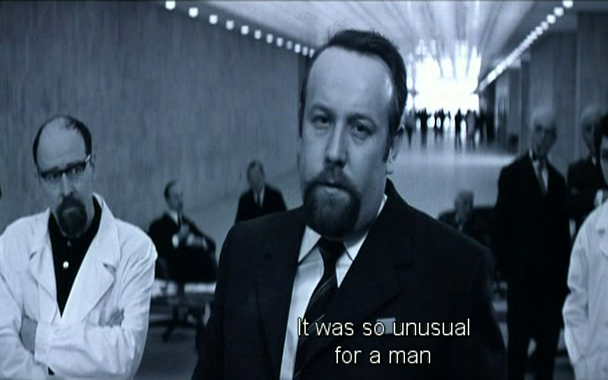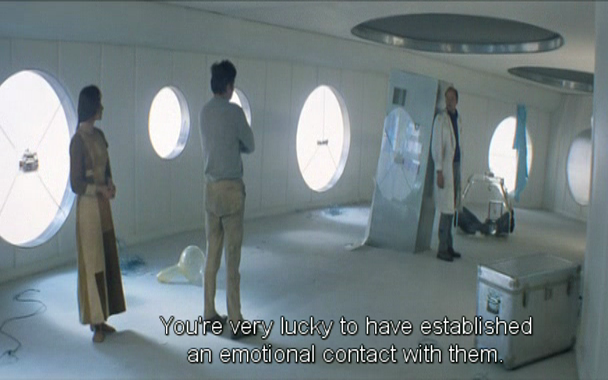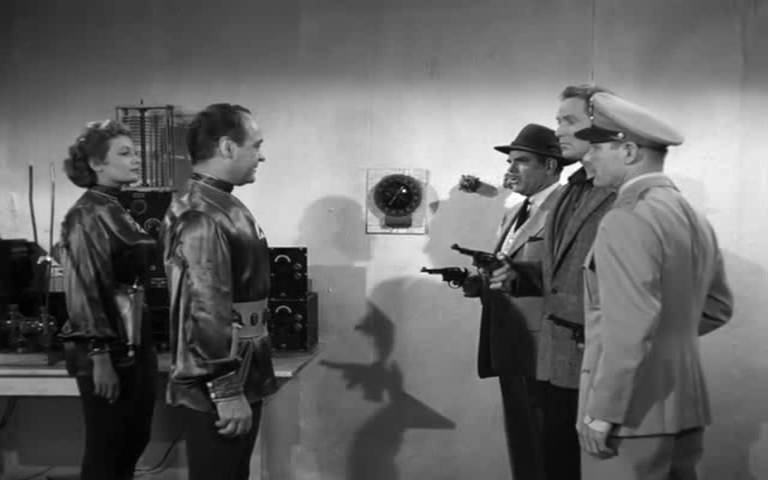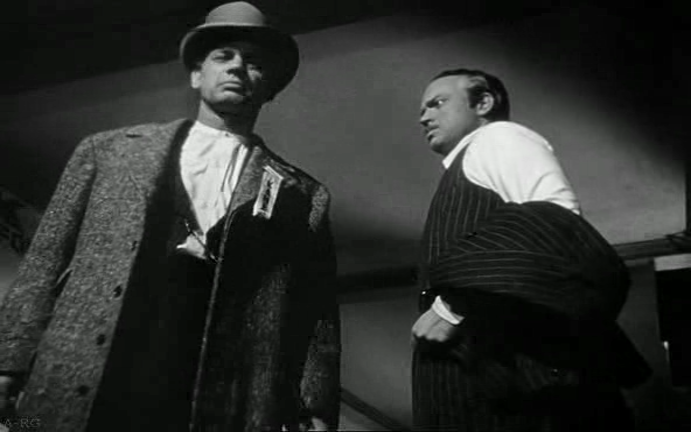-
#23 – Solaris (1972)
Solaris (1972)
Film review #23
Director: Andrei Tarkovsky
A sci-fi epic delving into the depths of an ocean planet and the human mind…Was this the Soviet Union’s 2001: A Space Odyssey?
Chris Kelvin, a psychologist is spending sometime with his parents at their home. He is reflecting on his life down by the lakeside before he is sent to a space station orbiting the oceanic planet Solaris the very next day. Before leaving, he destroys most of his possessions in a bonfire, and says goodbye to his Father, who he does not expect to see again.
Upon arriving at the space station, Kelvin learns that one his old friends, Dr. Gibarian is dead (having committed suicide), and the only two surviving crewmembers, Dr. Snaut and Dr. Sartorius are not forthcoming with information about what has happened, and act strange when Kelvin pushes them for answers. Snaut advises him to rest in the quarters, and everything will become clear…
Upon waking up from his sleep, a woman has appeared in his quarters, despite him blocking the doorway. It turns out it is Hari, his deceased wife. Not wanting to be taken in by this obvious trick, he tricks her into getting into an escape rocket and jettisons her into space, but burns himself on the exhaust rockets. While Dr. Snaut tends to his wounds, he explains that these “visitors” have appeared to everyone aboard, and are an incarnation of people they know, being generated by Solaris in some way.
Later, Hari appears before Kelvin again. When he leaves the room, she tears through a door after him. He watches her regenerate her injuries right before his eyes. When Dr. Sartorius calls a meeting with everyone, Kelvin introduces Hari as his wife and insists they treat her with respect. Sartorius reveals his latest discovery, that the “visitors” could be attacked with a radiation blast of x-rays. Hari realises she is not human, and composed of the memories of Kelvin’s dead wife. Eventually, Kelvin tells Hari how his real wife committed suicide ten years ago. Becoming increasingly unable to cope, Hari kills herself again by ingesting liquid oxygen. However, she soon recovers.
While he is sleeping, Kelvin dreams about his Mother. and multiple images of Hari. When he wakes up, Hari is not there. Snaut gives him a goodbye note from her, as she has gone to Sartorius and got him to destroy her. After broadcasting Kelvin’s brainwaves over Solaris, small islands have appeared all over Solaris. Now Kelvin has to make the choice of returning to Earth, or to live on Solaris where everyone he has known and loved has been reborn. In the end, we see Kelvin in front of his parent’s house, as the camera zooms up to reveal an island on Solaris…
I have previously watched the 2002 “re-make” of Solaris, but I was pleasently surprised to find they are two completely different movies, and the plot deviates at a number of points. This version is very much akin to Kubrick’s 2001: A SpaceOdyssey, which was released in the west about three years prior to Solaris. The movie is entirely Russian, which draws up interesting more interesting comparisons between eastern and western science-fiction. Running in at over two and a half hours, this is very much an epic story that focuses on a slowly revealed narrative and development. 2001 and Solaris have the theme of communication between alien species as a central theme. In 2001 this includes the relationship between man and machine too, and any extraterrestrial species is never revealed or explained. In Solaris, we are confronted with an alien form of consciousness that can penetrate into the mind and memories of humans, and the question of this being hostile communication or not plays an important part in the storyline. The music too is sparse and far between, the only reccuring music being Ich ruf’ zu dir, Herr Jesu Christ by Bach. The biggest contrast between the two is that while 2001has an exceptionally high budget and finely crafted sets, Solaris has a more sparse and limited design. Apparently the director wanted to heighten the focus on the characters rather than building an imaginary and complex future which other science-fiction does.
Perhaps it is unfair to compare the two movies so closely. Solaris is an epic tale in it’s own right and deserves to be looked at as an individual entity. The original novel, written by Polish writer Stanisław Lem was published in 1961. This adaption focuses on the human psychology of extraterrestrial contact and the impact it has on the central characters, while the original novel had more of a focus on the “futility of extraterrestrial contact”. The characters themselves are constantly put at odds with each other with their views as to what to do with Solaris, and whether it should be abandoned or understood. The compex relations between themselves and Solaris evokes all kinds of philosophical rationales to a viewer, never giving the answer, just merely asking the questions. Whereas science-fiction very much traditionally works around the premise of an imagined future, that aspect of science-fiction is very much disregarded in Solaris, giving no real indication of time and place, and focusing entirely on this complex relationship between unknown life.
Solaris was only released in five Russian cinemas originally, but it remained a staple of the cinemas for years, and earned it a cult status. It is a film that is still widely regarded as one of the most important in science-fiction, and while definitely not a casual, easy to watch film like the 2002 version, in my opinion it is worth finding the time to sit down and absorb its message.
-
#22 – Plan 9 from Outer Space (1956)
Plan 9 From Outer Space (1959)
Film review #22
Director: Ed Wood
A science-fiction movie by Ed Wood, sometimes dubbed “The worst movie ever made”. Does it live up (or down) to this reputation?
In the small town of San Fernando, California, two gravediggers are burying a young woman when they hear strange noises, upon deciding to leave, they are attacked and killed by the very young woman they were supposed to be burying. At the same time, a plane in the sky piloted by Jeff Trent witnesses a flying saucer hovering in the sky…Back at the cemetery, the husband of the young woman who died earlier has died himself, absorbed by grief. Mourners discover the bodies of the gravediggers, and alert the police. Inspector Clay and some police officers arrive to investigate, but Clay is attacked and killed by the re-animated corpses of the woman and old man…
Jeff Trent has returned home from his job as a pilot and is sitting on the porch of his home with his wife Paula, telling her about his encounter with the UFO. Suddenly, a strange gust of wind knocks them over. Flying saucers have now been spotted across the USA, but the government is refusing to acknowledge their existence. The army put Col. Edwards in charge of attacking these strange ships, which causes them to flee.
On Space Station 7, the saucers are regenerating, and we see the aliens for the first time, they say their mission to contact the governments of Earth has been unsuccessful, and since they will not acknowledge their existence, they decide to implement “Plan 9”: The resurrection of the recently deceased, to get the humans attention…
While Trent is away on another flight, the corpse of the old man rises again and sneaks into Paula’s house and chases her to the cemetery, where he is joined by the corpses of his wife and Inspector Clay. She is rescued by a passing driver after she is rendered unconscious and the corpses return to the alien spaceship. Meanwhile, at the Pentagon, Col. Edwards learns that the aliens have sent radio messages to Earth, but the government has not responded. He is sent to California, where most of the strange incidents have occurred.
After the old man appears on the porch of Trent’s home, Edwards, the police, Trent and his wife head to the cemetery, where they saw a strange light that apparently turned the old mans corpse into a skeleton. They find the alien spaceship, and learn that the aliens have been trying to contact Earth to warn them about “solarbonite”, a weapon the humans may soon discover which if used, would destroy the entire universe. A fight ensues, during which a fire starts, so the humans escape the ship, leaving the ship to blast off into space and explode…
This is certainly a cheap movie. Not just in terms of looks either. The sets are sparse and filmed obviously in front of a curtain, and supposedly sturdy walls and gravestones wobble and shake. The acting is amateur-ish, the script is full of grammatical errors, the special effects are cheap, and the stock footage is out of place. So why has this film not just disappeared into the annals of time to be forgotten about? The director/writer Ed Wood produced a number of these trashy movies in the 50’s, which all showed the cheapness which became a trademark of sorts. His flamboyant showmanship when he starred in his movies as well as directing them also made him a recognisable face in cinema at the time, garnering him some level of popularity.
Two years after Wood’s death, he was awarded the Golden Turkey award posthumously for being the “worst director ever”. This lead to a revival of his films and has lead to a cult-following. His love for making movies, despite his lack of proper resources, probably helped gain him this following.
Back to the movie, there are a number of continuity errors in the dialogue (the narrator refers to the story being in the future, than immediately refers to it in the past tense), and in one scene the shadow of a studio microphone can be seen over the set. All these things make the film very difficult to be taken seriously, yet still we are looking at an important piece of cinema history here, even if it isn’t a very good piece. Wood’s dedication and passion for film making under the poorest of situations give this movie a new light.
Not everything in this movie is bad. Some of the ending dialogue brings up some of the classic sci-fi questions. The aliens (Who look completely human) reveal their motives as trying to stop humans from inadvertently developing a weapon that would destroy the universe, and are just trying to defend themselves. They also refer to the “one God”, noting that humans aren’t the only species with a belief in God. This was probably added in because of a church bankrolling this film’s (limited) budget, but it is an interesting thought about how religion could transfer across space and time, similar to what we saw in The Day The Earth Stood Still (1951). Despite all this, the aliens are defeated and run away, and humanity is left with the possibility of annihilating itself and the universe. The choice for humanity to survive or destroy itself is apparently left in it’s own hands, as the narrator suggests. A cliché which has been done before, but a poignant message nevertheless.
So overall, Plan 9 From Outer Space is a little bit of cinema history, though not for its quality. Not a movie one can take seriously, but if you’re looking at the whole spectrum of sci-fi movies, this is almost an essential part.



















